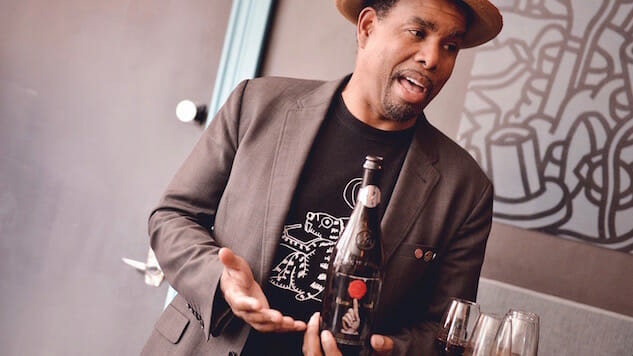4 Questions for Brooklyn Brewery’s Garrett Oliver
Photo via Brooklyn Brewery
Since 1987, Brooklyn Brewery has seen the beer scene turn over. As it evolves, brewmaster Garrett Oliver watches and makes the beer that interests him. Whether influenced by the low gravity of UK bitters, the growing beer culture in Scandinavia, or the continually changing American palate, Oliver finds something to pique his interest in both the history and future of beer.
For the most part, Brooklyn has been ahead of the curve. They introduced Scorcher, a session IPA, in 2004, and confused the world with its lesser alcohol content. Similarly, Oliver recalls the 1990s, when beers such as IPAs required their full name (India Pale Ale) to relay their message. Today, with 4,000 breweries open, he’s watching a new development in the IPA world and the potential boom or bust of sour beers. And he’s opinionated on those topics, as well as what Brooklyn’s role should be as modern brewers carve a new niche in the marketplace after years of being blanketed by louder, larger macro brands.
Paste: With a sister brewery in Sweden (Nya Carnegiebryggeriet), how do you view the growth of American style beers in Europe?
Garrett Oliver: We’ve gone from a situation where, as a younger brewer, I would go overseas and say, “Hey I’m Garrett, and I’m a brewer in the United States,” and they would say, “Oh yes, so sorry.” Their outlook was basically, “Your beers are dismal and nobody has any interest in them at all.” They didn’t know what was going on in American craft beer. Now everybody knows.
What’s fascinating is, take IPA: now the number one craft beer style. When I started brewing professionally in 1989, IPA was a historical British style that almost nobody brewed. At that time, IPA really wasn’t anything in the United States. Today, IPA is not a historical British style, it’s a modern American style. The place where you are least likely to taste a British style IPA is in Britain. What you have, by and large in the British brewing scene, is a super American outlook. And you see that being replicated all over the world.
We’re proud that we’ve made an impact, but eventually it gets a bit boring because everywhere you go people are brewing American IPA. We have 10,000 of those in the United States, so I’m not so interested in the foreign versions. What’s great is to see other countries move past that and discover themselves. Look at all the beer coming out of Brazil with distinct flavors that we can’t do in the United States because we don’t have those ingredients. That’s something that really excites me.
Paste: How do you view that evolution of the IPA in the bigger picture? Is that evolution a natural process?
Oliver: What we see right now, I would call it part of a recovery process. People often don’t realize that in a place like New York in the 1880s-1890s, you would have seen the most diverse beer culture in the world. We had everything: massive imports from Germany and the UK. We had New York breweries that specialized in weissbier or porter or IPAs. There was so much Guinness being drunk in New York City that they built a Guinness brewery on Long Island.
We forgot that history. We had everything already. When it comes back, we act like it’s new. What we have going on now—sour beers, IPAs, they do come back in slightly different forms with new ingredients. People might have a bigger cross pollination of ideas, with the way that people and ideas can travel these days. But I think that understanding the traditions is super important to knowing who you are and where you are in this flow of history, and that makes this whole thing so much deeper.
-

-

-

-

-

-

-

-

-

-

-

-

-

-

-

-

-

-

-

-

-

-

-

-

-

-

-

-

-

-

-

-

-

-

-

-

-

-

-

-








































